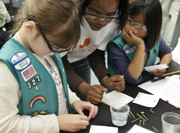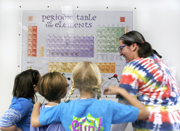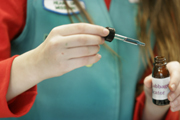The Magic of Chemistry

Professor Sheryl Tucker holds "glow-in-the-dark atomic worms" and demonstrates that some dye molecules impart not only color but also additional properties when interacting with light. In this case, the glow results from the molecules interacting with black light.
 Photo:
Photo:
Download larger image

Scouts Sloane (left) and Katie (far right) listen to student volunteer Jasmin Wright explain the M&M chromatography experiment. Students separate the food dye mixtures used to color the candy coatings. The dyes' properties determine how fast they creep up the filter paper when immersed in salt water, resulting in separation.
 Photo:
Photo:
Download larger image

Jena Whetstine (right), a graduate student in chemistry and volunteer at Camp Chemistry, blends in well with the colors of the periodic table she is showing to Girl Scouts.
 Photo:
Photo:
Download larger image

As part of the red cabbage lab, a student extracts color from a cabbage leaf to test pH and observe changes. Many vegetable extracts, such as those from red cabbage or grapes, contain the pigment molecule flavin, which changes color depending on pH.
 Photo:
Photo:
Download larger image